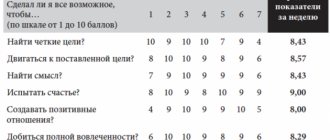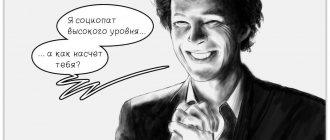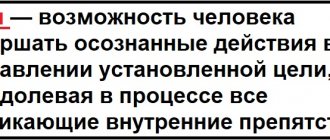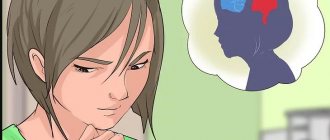Deviant behavior what is it
Deviant behavior is a set of human actions that form the basis of a model of behavior and response and go against the norms of behavior in society. It violates the usual conditions of social interaction. Current legislation provides for sanctions for such manifestations.
In sociology, a deviant act is understood as a real threat to human life and health in a particular situation.
Doctors, when interpreting the phenomenon of deviant behavior, focus on a person’s violation of the standards of interpersonal interaction as a result of deviations in mental development.
In pedagogy and psychology, deviant behavior is associated with a violation of social moral norms and disregard for cultural values. Teachers believe that a violation of norms and rules may be an isolated incident that will not be repeated after an educational conversation with a teenager. However, in the absence of punishment for misconduct, this model of behavior is consolidated and becomes a habitual stereotype of the individual’s response to external stimuli.
Psychologists are convinced that the appearance of deviations in behavior is not accidental; it is most often characteristic of adolescents - adolescence is characterized by a hormonal storm, uneven rates of development of personal structures, and the emergence of intrapersonal conflicts. This is a time of tense relationships with parents. Wanting to show his maturity, autonomy and independence, the teenager behaves defiantly.
Additional Information. A deviant is usually a teenager. The peak of deviant manifestations occurs at the age of 13-16 years. Statistical data from psychological studies indicate that after 18 years of age, the tendency to deviant behavior disappears.
Deviant teenager
Classifications of types of deviant behavior
Numerous attempts by researchers to systematize behavioral deviations have not yet led to the creation of a unified classification. The difficulties can be explained by several circumstances. The main reason is the interdisciplinary nature of the problem of behavioral deviations. Since the term “deviant / deviant behavior” is used in different sciences with different meanings, there are also diverse approaches to identifying its individual forms. Other important reasons explaining the existence of the problem include the wide variability of human behavior and the uncertainty of the very concept of “norm”. The norm, as a kind of abstract standard, is difficult to achieve in real life, and a person who is absolutely normal by all indicators simply does not exist.
All of the above circumstances significantly complicate both the identification of general criteria and the creation of a unified typology of various types of deviant behavior.
At the same time, systematizations exist and are widely used within individual disciplines. Conventionally, we can distinguish several main approaches to the problem of classifying behavioral deviations: sociological, legal, pedagogical, clinical and psychological.
Sociology considers behavioral deviations as social phenomena that are grouped on several grounds:
- depending on the scale, mass and individual deviations are distinguished;
- according to the significance of the consequences - negative (causing harmful consequences and creating potential danger) and positive;
- by subject - deviations of specific individuals, informal groups (for example, the activities of gangster groups), official structures, conditional social groups (for example, female alcoholism);
- by object - economic, domestic, property violations, etc.;
- by duration - one-time and long-term;
- by type of norm violated - crime, drunkenness (alcoholism), drug addiction, suicide, immoral behavior, vagrancy, prostitution, hooliganism, dependency, corruption, bureaucracy, terrorism, racism, genocide, destructive cults.
In law, deviant behavior refers to everything that contradicts currently accepted legal norms and is prohibited under threat of punishment (20). The leading criterion for the legal assessment of an individual’s actions is the degree of their social danger. According to the nature and degree of public danger of acts, they are divided into crimes, administrative and civil torts, and disciplinary offenses.
Crimes, in turn, depending on the degree of public danger, are divided into the following categories: minor gravity with punishment of up to two years; medium severity with a punishment of up to five years; serious crimes - up to ten years in prison; especially serious - over ten years of imprisonment or with a more severe punishment.
A special part of the Criminal Code contains a list of acts recognized as illegal and criminally punishable in Russia at the present time. In this section of the Criminal Code, crimes are divided into the following groups:
- crimes against the individual (against life and health; against the freedom, honor and dignity of the individual; against sexual integrity and sexual freedom of the individual; against the constitutional rights and freedoms of man and citizen; against family and minors);
- crimes in the economic sphere (against property; in the sphere of economic activity; against the interests of service in commercial and other organizations);
- crimes against public safety and public order (against public safety; against public health and public morality; environmental crimes);
- crimes against state power (against the foundations of the constitutional order and security of the state; against state power, the interests of civil service and service in local government; against justice; against the order of government);
- crimes against military service;
- crimes against peace and the security of humanity.
Thus, the Criminal and Civil Codes contain a list of various forms of deviant behavior from a legal point of view. Time gives birth to more and more new forms of legal deviations. This, in turn, necessitates constant changes to legislation.
The considered classifications can be supplemented with a pedagogical approach to behavioral deviations. In our opinion, pedagogical classifications are less differentiated and are often borrowed from other disciplines. In pedagogy, the concept of “deviant behavior” is often identified with the concept of “maladjustment”, and its bearer with the term “difficult student”. In light of the main pedagogical tasks, education and training of students, a student’s deviant behavior can be of the nature of both school and social maladjustment.
The structure of school maladjustment, along with its manifestations such as academic failure, disturbances in relationships with peers, and emotional disturbances, also includes behavioral deviations. Behavioral deviations that manifest themselves directly in the educational process may include: hyperactive behavior, disciplinary violations (lateness, failure to comply with school rules, truancy), aggressive behavior, smoking, hooliganism, lying, theft.
Signs of a larger social maladjustment at school age may include: regular use of psychoactive substances (volatile solvents, alcohol, drugs), non-chemical addictions (computer and gaming addiction, TV series addiction, Internet addiction, food addictions), sexual deviations, prostitution , vagrancy, committing crimes.
Medical classification of behavioral disorders is based on psychopathological and age-related criteria. In accordance with them, behavioral disorders are identified that meet medical diagnostic criteria, i.e., reaching the level of illness. The International Classification of Diseases, 10th revision, in the section “Classification of mental and behavioral disorders” names the following behavioral disorders (for adults):
- F10-19 - mental and behavioral disorders due to the use of psychoactive substances (alcohol use; opioids; cannabinoids; sedatives and hypnotics; cocaine; stimulants, including caffeine; hallucinogens; tobacco; volatile solvents; combined use or use of other psychoactive substances);
- F50-59 - behavioral syndromes associated with physiological disorders and physical factors (eating disorders; sleep disorders of non-organic nature; sexual dysfunction not caused by an organic disorder or disease; mental and behavioral disorders associated with the postpartum period; abuse of non-addictive substances , for example steroids, vitamins);
- F63 - disorders of habits and impulses (pathological gambling; pathological arson - pyromania; pathological theft - kleptomania; hair pulling - trichotillomania; other disorders of habits and impulses);
- F65 - disorders of sexual preference (fetishism; fetishistic transvestism; exhibitionism; voyeurism; pedophilia; sadomasochism; multiple disorders of sexual preference). Note that in this edition there is no homosexuality.
These sections contain a list of specific diagnostic criteria and signs according to which this behavior can be classified as a painful disorder. For example, the heading “Pathological theft (kleptomania)” in the international classification of diseases contains the following diagnostic signs:
- two or more instances of theft without apparent motive or benefit to the individual or another person;
- the individual describes a strong desire to steal with a feeling of tension before committing the act and relief after it.
The International Classification of Diseases (ICD-10, 1994) also includes a typology of behavioral disorders with onset characteristic of childhood and adolescence: F90 - hyperkinetic disorders; F-91 - conduct disorder (F-91.0 - conduct disorder limited to the family environment; F-91.1 - unsocialized conduct disorder; F-91.2 - socialized conduct disorder; F-91.3 - oppositional defiant behavior; F-91.8 - others; F -91.9 - conduct disorder, unspecified); F-92 - mixed behavioral and emotional disorders; F94 - social functioning disorder; F-95 - tic disorders; F-98.0 - inorganic enuresis; F-98.1 - inorganic encopresis; F-98.2 - feeding disorder in infancy; F-98.3 - eating inedible; F-98.4 - stereotypical movement disorders; F-98.5 - stuttering; F-98.6 - speech excitedly. These behavioral disorders are diagnosed when several characteristic symptoms are present, which must persist for at least six months.
In addition to the main systematization, more specific classifications are also used. Conduct disorders in childhood are divided into two main subgroups: socialized forms of antisocial behavior and unsocialized aggressive behavior. Children and adolescents of the first group adapt well within antisocial groups and do not show signs of emotional disorders when committing antisocial acts in the group. Representatives of unsocialized aggressive behavior, on the contrary, are in very poor relations with their immediate environment - other children and family; They are characterized by hostility, negativism, insolence and vindictiveness.
Deviant behavior of adolescents is widely covered in the domestic medical literature. It usually includes such forms as delinquent (illegal) behavior; early use of alcohol and drugs; deviations of sexual behavior; suicidal behavior; running away from home and vagrancy. At the same time, while developing primarily clinical aspects of disrupted behavior in adolescents, researchers point to the leading role of its socio-psychological determinants.
The psychological approach is based on identifying socio-psychological differences in certain types of deviant behavior of an individual. Psychological classifications are built on the basis of the following criteria: type of norm violated; psychological goals of behavior and its motivation; the results of this behavior and the damage it causes; individual-style characteristics of behavior.
Within the framework of the psychological approach, various typologies of deviant behavior are used. A number of authors have identified three main groups of behavioral deviations: negative (for example, drug abuse), positive (for example, social creativity) and socially neutral deviations (for example, begging).
Ts. P. Korolenko and T. A. Donskikh (19) divide all behavioral deviations into two large groups: non-standard and destructive behavior. Non-standard behavior can take the form of new thinking, new ideas, and actions that go beyond social stereotypes of behavior. The typology of destructive behavior is built in accordance with its goals. In one case, these are externally destructive goals aimed at violating social norms (legal, moral, ethical, cultural) and, accordingly, externally destructive behavior. In the second case, there are intra-destructive goals aimed at the disintegration of the personality itself, its regression, and, accordingly, intra-destructive behavior.
The authors, in turn, divide externally destructive behavior into addictive and antisocial. In the group of intra-destructive behavior, the following are distinguished: suicidal, conformist, narcissistic, fanatical and autistic behavior.
Suicidal behavior is characterized by an increased risk of suicide; conformist - behavior devoid of individuality, focused exclusively on external authorities; the narcissistic is driven by a sense of grandiosity; the fanatical appears in the form of blind adherence to any idea or view; autistic manifests itself in the form of immediate isolation from people and the surrounding reality, immersion in the world of one’s own fantasies.
In the psychological literature one can find other classifications, for example, based on criteria such as the type of norm violated and the nature of the negative consequences of deviant behavior. In accordance with the listed characteristics, we distinguish three groups of deviant behavior:
- antisocial (externally destructive);
- asocial (displaced-destructive);
- dissocial (autodestructive).
Antisocial (externally destructive) is behavior that is contrary to legal norms and threatens social order and the well-being of people around. It includes any actions or inactions prohibited by law in the form of anti-disciplinary, illegal and antisocial acts. In some cases, antisocial behavior is associated with illegal and delinquent behavior.
Antisocial behavior (displaced-destructive) is behavior that deviates from fulfilling moral standards and threatens the well-being of interpersonal relationships. This behavior is regulated by social groups and moral standards (religious norms, professional requirements, professional ethics, school rules, etc.). Antisocial behavior of adults can manifest itself in the following forms: violation of professional ethics, aggressive behavior, sexual deviations, vagrancy, dependency, extortion, prostitution, etc.
The boundaries of antisocial behavior are especially variable because it, more than other behavioral deviations, is influenced by culture and time. In its expressed form, antisocial behavior coincides with mild forms of antisocial behavior and is often also designated as delinquent.
Dissocial (autodestructive) is behavior that deviates from medical and psychological norms, threatening the integrity and development of the personality itself. Self-destructive behavior in the modern world appears in the following main forms: suicidal behavior, food addiction, chemical addiction (substance abuse), non-chemical addictions (gaming, computer, Internet addiction, etc.), fanatical behavior (for example, involvement in destructive religious cult), autistic behavior, victim behavior (victim behavior), activities with a pronounced risk to life (extreme sports, significant speeding when driving a car, etc.).
Thus, various types of deviant behavior of an individual are located on a single axis “destructive behavior” with two opposite directions - towards oneself or towards others. Based on the direction and severity of destructiveness, we can imagine the following scale of deviant behavior: antisocial (active-destructive) - prosocial (relatively destructive, adapted to the norms of the antisocial group) - asocial (passive-destructive) - dissocial (passive-self-destructive) - suicidal (actively destructive). self-destructive).
A special place among deviantological classifications is occupied by the so-called multi-axis approaches. Using the example of illegal behavior, V.V. Kovalev identifies three axes and the corresponding forms of deviation:
- on the socio-psychological axis - anti-disciplinary, antisocial and illegal behavior;
- on the clinical-psychopathological axis - non-pathological and pathological forms;
- on the personal-dynamic level - reactions, state and development.
V. D. Mendelevich differentiates types and forms of deviant behavior. Types include:
- delinquent (asocial and antisocial);
- addictive;
- pathocharacterological;
- psychopathological;
- associated with hyperpowers.
At the same time, individual forms of deviant behavior are: aggression; suicidal behavior; substance abuse; eating disorders; abnormalities of sexual behavior; extremely valuable psychological hobbies (non-chemical addictions); characterological and pathocharacterological reactions (emancipation, grouping, opposition, etc.); communicative deviations (autism, hyper sociability, jealousy, conformism, etc.); immoral and immoral behavior; unaesthetic behavior. Each of the forms can be caused by any type or several types of deviant behavior.
The identification of individual types of deviant behavior and their systematization according to similar characteristics are conditional, although justified for the purposes of scientific analysis. In real life, individual forms are often combined or intersected, and each specific case of deviant behavior turns out to be individually colored and unique.
A comparison of psychological and medical classifications allows us to conclude that they do not contradict, but complement each other. In some cases, the same type of behavior can successively acquire different forms: a harmless bad habit - deviant behavior that worsens the quality of life - a painful behavioral disorder that threatens life itself.
Definition of deviations
Deviation is a deviation from the standard in psychology. This is a violation of the norms of human existence and activity. This is a protest against established rules. Deviation is a person’s refusal to follow stereotypes, which poses a threat to others and to the person himself. The opposite concept for deviation is conformity.
Deviant behavior in adolescents - what does it mean in a child?
In social conditions, deviations are manifested by ignorance, drug addiction, alcoholism, kleptomania, and revolutionary acts. The cause of deviations is the difficulties of socialization of the individual.
Attention! Deviations are not only negative, but also positive. For example, positive deviations include the manifestation of creative abilities, talent, innovation in a particular area. However, both negative and positive deviations cause a wary, disapproving attitude on the part of others.
Causes of personal deviation
Types of conflicting personalities - what they are and their characteristics
Among the main reasons for deviant behavior are:
- Hormonal storm and puberty. These processes may be accompanied by emotional outbursts, pathologies of sexual desire, self-doubt, adaptation difficulties, impulsiveness, rapid mood swings, and an early sense of adulthood.
- Painful perception of criticism. The situation is aggravated by the spasmodic nature of a teenager’s physiological development: due to external disproportion, angularity, and acne, teenagers have complexes and may not control their reactions when it comes to their appearance.
- Abuse of a teenager by peers or parents.
- Character accentuations, negative personality traits.
- The presence of mental retardation or psychopathology.
- Teenage stubbornness, a child’s desire to prove to everyone what he is really worth and what he is capable of. Teenagers fiercely defend the right to freedom and independence.
- Desire to expand your circle of friends.
Teen company
- Genetic predisposition. An unfavorable situation in the family and raising a child in a single-parent family create conditions for the deformation of the moral foundations of a growing person.
- Lack of control of the student, little participation of parents in the life of a teenager. Often, weak control on the part of parents leads to the fact that a teenager tries alcohol and starts smoking early. This may increase the risk of adolescents using psychotropic substances. Teenagers cannot give up a cigarette, a drink or drugs, since their peers mean a lot to them. In addition, teenagers try forbidden foods out of curiosity, believing that they can completely refuse them in the future if they want.
Symptoms and signs of deviant behavior
Child abuse - what is it?
Actions deviating from the norm are characterized by the following characteristics:
- Difficulties in social adaptation;
- Transition of illegal actions into a persistent pattern of behavior;
- Destructive or self-damaging nature of human actions;
- The behavioral reactions of a deviant cause negative evaluation and condemnation from others.
Attention! Deviations cannot be equated with attempts at self-expression, called eccentricity and explained by individual characteristics. Unlike other personal and age-related characteristics, they always cause harm to the person himself and society.
TopPsychology
Psychopathological criterion
used in medicine. From the point of view of psychopathological criteria, all behavioral manifestations can be divided into two groups: normal
and pathological
in the meaning of “health – illness”. In the classification of diseases, deviant behavior is not identified as a separate nosological unit; therefore, it is neither a form of pathology nor a strictly defined medical concept. At the same time, deviant behavior is widely considered among the phenomena lying between normality and pathology. Treatment of allergies in sanatoriums of the Krasnodar region san-lab.ru.
The next, social-normative, criterion
is extremely important in various areas of public life. According to this criterion, behavior that meets the requirements of society at a given time is perceived as normal and approved. Deviant behavior, on the contrary, contradicts basic social attitudes and values. As society itself changes, the social norms that operate within it also change.
The last, individual psychological criterion
reflects the ever-increasing value of each person, her individuality.
In accordance with this criterion, modern requirements for a person are not limited to his ability to fulfill social requirements, but also presuppose self-knowledge and the original existence of the individual. In this regard, the fundamental qualities of an individual in our era can be called: its internal position in relation to the outside world and itself, the ability to make decisions and choices, as well as personal responsibility for one’s own behavior. Self-determination in the social space and self-realization of personal potential in it are recognized as the leading tasks of individual development.
Definition of the concept
The subject of our study is only those aspects of individual behavior that can be qualified as deviant behavior. It is advisable to highlight those specific features of deviant behavior of an individual that will help us distinguish it from other phenomena, and also, if necessary, state its presence and dynamics in a particular person.
1. Deviant personal behavior is behavior that does not correspond to generally accepted or officially established social norms. However, this is not a violation of any, but only the most important social norms for a given society at a given time.
2. Deviant behavior and the personality that manifests it cause negative evaluation from other people. Negative evaluation can take the form of public condemnation or social sanctions, including criminal punishment. First of all, sanctions serve the function of preventing unwanted behavior. But, on the other hand, they can lead to such a negative phenomenon as personal stigmatization. A person’s attempts to start a new life are often frustrated by the mistrust and rejection of those around him. Gradually, the label of a deviant (drug addict, criminal, suicide, etc.) forms a deviant identity. Thus, a bad reputation increases dangerous isolation, prevents positive change, and causes relapse into deviant behavior.
3. A feature of deviant behavior is that it causes real damage to the person himself or to the people around him. In its extreme manifestations, deviant behavior poses an immediate threat to life, for example, suicidal behavior, violent crimes, and the use of “hard” drugs. The psychological marker of damage is the suffering experienced by the person himself or those around him.
Pages: 2
Types of communications. Verbal Communication In verbal communication, two types of speech are common - oral and written. Written speech is that which is taught in school and which is used to be considered a sign of a person’s education. Written speech is cumbersome and often contains cliches and bureaucracy, but this is the price for accuracy and unambiguousness of sentences and text. Written speech does not allow...
Methods for studying a child’s understanding of prepositions Preparing a study Prepare a box of colored pencils, a saucer, a cup, a spoon, a box of paper, a circle with a diameter of 3 cm. Conducting a study. The study is carried out individually with children 2-5 years old. The experimenter asks the child to complete a number of tasks: 1. Take a pencil out of the box 2. Put the pencil behind the box...
Basic techniques of group counseling in various approaches There are several theoretical approaches that have their own name, form their own goals, stages of development of group work, define the role and functions of the group consultant, and also offer many different strategies and techniques of influence in group counseling. Approaches Techniques Psychoanalytic approach ...
Classification of deviations by type of approach to the problem
In the scientific literature, it is customary to classify deviations depending on the approach to their study.
Socio-legal approach
According to the socio-legal approach, deviant forms of behavior include all actions for which punishment is provided, since they are regarded as a violation of the law. They are legally recognized as socially dangerous and are divided into disciplinary offenses, crimes and torts.
The punishment for illegal actions is chosen depending on the severity of the act committed. The Criminal Code provides for liability for crimes:
- Mild severity;
- Moderate severity;
- Serious crimes;
- Particularly serious crimes.
The socio-legal approach also divides crimes depending on the nature of the actions. Stand out:
- Crimes against the person;
Crime against the person
- Crimes against public authorities;
- Crimes against security;
- Crimes against military service;
- Economic crimes.
Medical approach
The medical approach takes as the basis for the classification of deviant behavior the physiological characteristics of adolescence, character accentuations and the measurement of neuropsychic abnormalities, perverted forms of psychobiological needs. Proponents of this approach are convinced that deviations in behavior will not disappear on their own; you need to seek help from specialists.
According to the medical approach, it is customary to distinguish such forms of deviant behavior as:
- Mental instability, manifested in a strong emotional reaction;
- Frenzied anger;
- Various phobias;
- Hyperactivity;
- Theft;
- Tendency to lie;
- Animal abuse;
- Negativism;
- Vagrancy.
Psychological approach
The classification of deviant behavior in the psychological approach is based on the socio-psychological characteristics of its varieties. Psychologists distinguish such types of deviant behavior as:
- Negative type (use of drugs, alcohol);
- Positive type (all types of creativity and positive self-expression of adolescents);
- Socially neutral type (begging).
Psychological classifications of deviant behavior
Behavioral norm and deviations in behavior
3. Psychological classifications of deviant behavior
The difficulty of raising a child, his failure to comply with the norms and rules established in society, is considered in science through a phenomenon called deviation.
Deviation (deviation) is one of the aspects of the phenomenon of variability, which is inherent in both man and the world around him. Variability in the social sphere is always associated with activity and is expressed in human behavior, which represents his interaction with the environment, mediated by the external and internal activity of the child. As mentioned earlier, behavior can be normal and deviant.
Deviations include deviant, delinquent and criminal behavior.
Deviant behavior is one of the types of deviant behavior associated with a violation of age-appropriate social norms and rules of behavior characteristic of microsocial relationships (family, school) and small age-sex social groups. Delinquent behavior, in contrast to deviant behavior, is characterized as repeated antisocial offenses of children and adolescents, which develop into a certain stable stereotype of actions that violate legal norms, but do not entail criminal liability due to their limited social danger or the child not reaching the age at which criminal charges begin. responsibility.
Criminal behavior is defined as an unlawful act, which, upon reaching the age of criminal responsibility, serves as the basis for initiating a criminal case and is qualified under certain articles of the criminal code. Criminal behavior is usually preceded by various forms of deviant and delinquent behavior.
Psychological classifications are based on the following criteria:
- type of norm violated;
— psychological goals of behavior and its motivation;
- the results of this behavior and the damage caused by it;
- individual - style characteristics of behavior.
Ts.P. Korolenko and T.A. Donskoys divide behavioral deviations into two large groups: non-standard and destructive behavior. In the psychological literature one can find other classifications of deviant behavior.
Classification of behavioral deviations based on leading criteria, such as the type of norm violated and the negative consequences of deviant behavior. There are three main groups of deviant behavior: antisocial, asocial, and self-destructive behavior.
Antisocial (delinquent) behavior is behavior that is contrary to legal norms and threatens the well-being of people.
Among teenagers, the following types predominate: theft, robbery, vandalism, violence. In childhood, forms such as violence against younger children or peers, cruelty to animals, theft, and arson are common.
Antisocial behavior is behavior that evades moral standards and directly threatens the well-being of interpersonal relationships. It can manifest itself as aggressive behavior, sexual deviations, involvement in gambling for money, and vagrancy.
In adolescence, the most common are leaving home, school absenteeism, lying, aggressive behavior, graffiti, and subcultural deviations.
Children are more likely to run away from home, vagrancy, school absenteeism, aggressive behavior, slander, lies, and theft.
The boundaries of antisocial behavior are especially variable because it, more than other behavioral deviations, is influenced by culture and time.
Autodestructive (self-destructive) behavior is behavior that deviates from medical and psychological norms, threatening the integrity and development of the personality itself. Self-destructive behavior in the modern world appears in the following forms: suicidal behavior, food addiction, chemical addiction, autistic behavior, activities with a pronounced risk to life.
A specific feature of self-destructive behavior in adolescence is its mediation by group values. In such groups, drug addiction, self-cutting, computer addiction, and more are observed.
In childhood, smoking and substance abuse occur, but in general, autodestruction is not typical for this age period.
Based on the direction and severity of destructiveness, the following scale of deviant behavior can be presented: antisocial prosocial - asocial - self-destructive - suicidal
In life, individual forms are often combined or intersected, and each specific case of deviant behavior turns out to be individual and unique.
4. Characteristics of deviant behavior
It is obvious that deviant behavior is one of the manifestations of social maladjustment. Speaking about child and adolescent maladjustment, it is necessary to clarify the categories of children who are susceptible to this process:
- children of school age who do not attend school (in our country there are about 7% of them, i.e. approximately 1.5 million);
— orphans, the total number of which exceeded 500,000;
— social orphans; the reality is that due to the limited space in orphanages, children wait for months to be placed in an orphanage, living with parents deprived of parental rights, not having normal food, clothing, and being subjected to physical, mental, and sexual violence;
- teenagers who use drugs and toxic substances;
- teenagers with sexually promiscuous behavior;
- teenagers who have committed illegal acts; According to official data, their number among children and adolescents is growing twice as fast as among adults.
Depending on the type of norm violated, deviant behavior is classified according to the following characteristics:
— types of crime (criminal, administrative) and immoral acts (drunkenness, prostitution);
— the level or scale of deviation, when it is customary to talk about individual or mass deviation;
- the internal structure of deviation, when deviation is associated with belonging to a particular social group, gender and age characteristics;
- orientation of deviation towards the external environment (family quarrels, violent crimes, etc.) or towards oneself (suicide, alcoholism, etc.).
A child whose behavior deviates from socially accepted rules and norms of behavior is called difficult or difficult to educate. Difficulty in education is understood as resistance to pedagogical influences, which can be due to a wide variety of reasons related to the assimilation of certain social programs, knowledge, skills, requirements and norms in the process of targeted training and education.
Conclusion
Teaching a child the social experience that humanity has accumulated, the culture of the country where he was born and growing up, its moral standards, and the traditions of the people is the direct function of parents. It is in the family that the foundations of a person’s morality are laid, norms of behavior are formed, and the inner world and individual qualities of a person are revealed. The family contributes not only to the formation of personality, but also to a person’s self-affirmation, stimulates his social and creative activity, and reveals his individuality.
Proper organization of free time helps improve the health and physical development of the child.
The need to regulate people's behavior will always remain relevant, since there is an insoluble contradiction between human needs and the possibilities of satisfying them. Factors of deviant behavior can be the psychological insensitivity of an individual to the social norms established by society or the genetic predetermination of deviance.
List of used literature
1. Azarov Yu. P. Family pedagogy. - M., 1989.
1996. 6. Andreeva G. M. Social psychology. - M., 1996.
2. Bozhovich L. I. Personality and its formation in childhood. - M., 1968
3. Bocharova V. G. Social pedagogy. - M., 1994.
4. Gazman O. S. Education: goals, means, prospects: New pedagogical thinking. - M., 1989.
5. Zakharov A.I. How to prevent deviations in a child’s behavior. - M., 1986.
6. Zakharov A.I. Prevention of deviations in child behavior. St. Petersburg, 1997.
7. Zmanovskaya E.V. Deviantology (psychology of deviant behavior). - M., 1998.
8. Social maladjustment: Behavioral disorders in children and adolescents. - M., 1996.
Behavioral norm and deviations in behavior
Information about the work “Behavioral norm and deviations in behavior”
Section: Psychology Number of characters with spaces: 14376 Number of tables: 0 Number of images: 0
Similar works
Conflict as a factor in the formation of deviations in the behavior of military personnel
158333
17
14
... prone to conflicts and behavioral deviations, comprehensive psychological testing of conscripted military personnel was carried out. Object of study: deviations in the behavior of military personnel. Subject of research: conflict as a factor in the formation of deviations in the behavior of military personnel. Purpose of the study: to experimentally show the influence of conflicts on the commission of deviations in behavior...
Deviant behavior of an individual in an organization
46466
4
1
...at all levels, time theft, evasion, tax evasion, payroll falsification, sabotage and so on. Thus, deviant behavior is any behavior that is not officially approved by the management of the organization and includes unauthorized transfers of resources to employees and managers. It should be noted that this phenomenon has a rather long history - from Egypt...
The use of fairy tales in correcting deviations in the behavior of younger schoolchildren
49060
3
0
... warns that the current situation is further unbearable for the child (for example, vomiting as a rejection of an unpleasant painful situation at school). 1.3 Features of using fairy tales in correcting deviations in the behavior of primary schoolchildren One of the effective methods of working with children experiencing certain emotional and behavioral difficulties is fairy tale therapy. Fairytale therapy -...
Social norms and deviations
56078
2
0
… In simple societies with a small number of members and a simple structure of norms, deviant behavior is easily identified and controlled. In societies with a complex structure of often contradictory social norms, the problem of deviations from generally accepted behavior grows to very significant proportions. Two ideal types of deviations can be distinguished: 1) individual deviations, when an individual ...
Classification according to the structure of deviant behavior
According to the structure, deviations are usually divided into antimoral, addictive, delinquent, and suicidal.
Addictive behavior
It is based on the desire to get rid of psychological discomfort through such means as gambling, alcohol, workaholism, and overeating. Addictive deviance is dependence, subordination of thoughts and actions to a certain object. With this type of deviant behavior, a person is not capable of self-control of actions and hobbies.
Addictive behavior
Delinquent behavior
This response model poses a threat to people’s lives and health. These are the names of crimes for which criminal liability is provided.
Antimoral behavior
This is a deviant type of violation of the moral and ethical principles of society. The framework of morality is very individual: for one person, profanity is unacceptable, since he considers it anti-moral, for another it is a familiar style of communication.
Suicide
Suicidal behavior is a form of thinking in which a person who finds himself in a difficult life situation prefers to stop trying to cope with it by taking his own life. A suicide attempt is a risk factor - after it, the teenager will be registered with a clinical psychologist and psychiatrist.
Timepsychology
The psychopathological type of deviant behavior is based on psychopathological symptoms and syndromes that are manifestations of certain mental illnesses. A variety of pathocharacterological, psychopathological and addictive types of deviant behavior is self-destructive (autodestructive) behavior. Its essence lies in the fact that the system of human actions is aimed not at development and personal growth, and not at harmonious interaction with reality, but at the destruction of personality. Aggression is directed towards oneself (auto-aggression), inside the person himself, while reality is viewed as something oppositional, which does not provide the opportunity for a full life and satisfaction of urgent needs. Autodestruction manifests itself in the form of suicidal behavior, drug addiction and alcoholism, and some other types of deviations. The motives for self-destructive behavior are addictions and the inability to cope with everyday life, pathological changes in character, as well as psychopathological symptoms and syndromes.
Deviations caused by human hyperabilities are considered a special type of deviant behavior (K.K. Platonov). A person whose abilities significantly and significantly exceed the average statistical abilities is considered to be beyond the ordinary, normal. In such cases, they talk about manifestations of giftedness, talent, genius in any one of the human activities. Deviation towards giftedness in one area is often accompanied by deviations in everyday life. Such a person often turns out to be unadapted to “everyday, mundane” life. He is unable to correctly understand and evaluate the actions and behavior of other people, and turns out to be naive, dependent and unprepared for the difficulties of everyday life. Behavior associated with hyperabilities involves ignoring reality. Forced contacts are perceived by a person with hyperabilities as optional, temporary and not perceived as significant for his personal development. Outwardly, in everyday life, the actions of such a person may be of an eccentric nature. For example, he may not know how to use household appliances or how everyday actions are performed. His entire interest is focused on activities related to extraordinary abilities (musical, mathematical, artistic and others).
Deviant (deviant) behavior has the following clinical forms:
• aggression
• auto-aggression (suicidal behavior)
• abuse of substances that cause states of altered mental activity (alcoholism, drug addiction, smoking, etc.)
• eating disorders (overeating, starvation)
• anomalies of sexual behavior (deviations and perversions)
•extremely valuable psychological hobbies (“workaholism”, gambling, collecting, “health paranoia”, religious fanaticism, sports, music, etc.)
•extremely valuable psychopathological hobbies (“philosophical intoxication”, litigiousness and querulanism, types of mania - kleptomania, dromomania, etc.)
•characterological and pathocharacterological reactions (emancipation, grouping, opposition, etc.)
•communicative deviations (autization, hyper sociability, conformism, pseudology, narcissistic behavior, etc.)
• immoral and immoral behavior
Pages: 4
The importance of the sibling position for the development of a child’s personality Sibling position is (from the English sibling brother or sister) an individual’s behavior strategy in relation to his brothers and/or sisters. The following formal positions are distinguished: eldest child, youngest child, middle child, only child, twin. Each position has a typical (normal) style of interaction and functioning of individual...
Conflict management: forecasting, prevention, regulation and resolution. The banal phrase “prevention is easier than resolution” does not work when applied to conflict. It doesn’t work mainly for two reasons: 1. not all conflicts need to be prevented (and we cannot live without conflict at all, we must react to our negative impulses) 2. even those conflicts that need to be prevented are very difficult...
Localization of higher mental functions in the cerebral cortex 1. The brain as a substrate of mental functions works as a single whole, consisting of many highly differentiated parts, each of which plays its own specific role. 2. Systemic localization of higher mental functions presupposes a multi-stage hierarchical multi-level brain organization of each function. 3. Localization...
Correction of deviant behavior
Correction of deviant behavior is one of the areas of work of a psychologist. First, the reasons why the child began to deviate from the norm are determined. Depending on the cause of deviation, the psychologist chooses methods of working with the minor. The work is aimed at developing educational motivation, a system of values and personal attitudes, and general correction of behavior.
The success of psychological interventions depends on the volitional qualities of the teenager, his suggestibility and interest in positive changes. A favorable atmosphere in the family is also very important for positive changes.
At the end of the course, the specialist gives brief recommendations to parents on how to organize communication with a teenager. This means that not only the teenager, but also his legal representatives attend consultations.
Important! To develop socially approved behavior in a teenager, a positive example is extremely important. Signs of a problem cannot be ignored. Even if deviations have appeared in the child’s behavior, they can be corrected if you do not postpone a visit to specialists.
Correction of deviations










